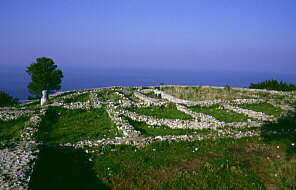|
Villa di Damecuta
The imperial Villa di Damecuta
lies on the western side of the island. In fact, although situated at
differ-ent heights, the three Roman villas of Capri - Villa di Damecuta,
Villa Jovis and Villa di Palazzo a Mare - occupy the whole of the islandís
coastline and provide a complete view of the Gulf of Naples from Punta
Campanella to Ischia.
Famous for the discovery of ancient buildings
and marble fragments, Villa di Damecuta became a military training ground
at the beginning of the 19th century and a fort was built there during
the battles between the English and the French for the possession of the
island. However, many of the ancient remains which came to the surface
were tampered with or reused by local labourers who did not hesitate to
destroy or sell many ancient columns and marble slabs.
It is difficult to calculate the original
extension of Villa di Damecuta as only a few buildings remain scattered
along the edge of the rocky ridge, characterized by imposing arched foundations.
 Several areas of the largest complex remain, organized in a semicircular
fashion. Although the function of these buildings is rather uncertain,
they could include a viewpoint (A), which opens onto the long loggia of
the ambulatio (promen-ade). Floored in cocciopesto, the ambulatio (B)
was open on the sea side while several brick columns covered in plaster
perhaps served to sustain a pergola. On the land side, the loggia was
delimited by a wall with several niches for benches.
Several areas of the largest complex remain, organized in a semicircular
fashion. Although the function of these buildings is rather uncertain,
they could include a viewpoint (A), which opens onto the long loggia of
the ambulatio (promen-ade). Floored in cocciopesto, the ambulatio (B)
was open on the sea side while several brick columns covered in plaster
perhaps served to sustain a pergola. On the land side, the loggia was
delimited by a wall with several niches for benches.
Opposite the viewpoint, near the Medieval
tower (in red), the living quarters could be accessed by following a steep
stairway (C D E). Traces of plaster still remain on the walls and the
ruins of mosaic flooring can still be seen in the small cubiculum (bedroom)
(G) in which a nude Ephebic torso was found. The villa followed the typical
Roman villae maritimae plan as it was situated in a dominant position
with the sea as the main element of the landscape and includ-ed characteristic
natural areas in carefully selected panoramic positions.
The etymology of the name Damecuta is uncertain.
|

Parte della zona di rappresentanza

Part of the entertainments area (A)


Loggia of the ambulatio (B)
|




